Final report for LS14-263
Project Information
The aim of this project was to facilitate the cohesive socioeconomic development of urban farmers by local governments, with a focus on existing limited-resources farmers in small size holdings in disadvantaged neighborhoods, to strengthen the food system and increase urban dweller resilience against the challenges of the XXI Century (i.e., climate change, lack of food security, economic instability, and shortage of locally produced agricultural commodities, among others).
This research constitutes the first study with a systematic approach to urban agriculture in Puerto Rico, using as a case study the Autonomous Municipality of San Juan. One of the most important study contributions is providing data about operation of community-based urban orchards and their social, environmental and economic benefits for the San Juan communities. We studied 15 urban agriculture initiatives at the Municipality of San Juan, which are going through various stages of development. Essentially the analyzed urban orchards operate a smaller scale endeavor with a reduced group of volunteers and have been operating for a little while. Most of the orchards are in under-developed spaces at low income communities of the Municipality of San Juan. The plots of land are mostly rescued, borrowed or rented. Although limited in quantity, urban farmers produce a variety of vegetables, fruit and leaf and, in lesser amounts, tubers and grains. The sowing methods mostly used are elevated sowing beds, farming directly to the ground and using containers, such as wheels and large cans. Most of them practice a form of agroecology and perceive an interest in other people for this kind of product, while indicating that they need to boost promotion for their effort.
Most of the orchards originated in response to a need to maintain or productively use an abandoned site in the community. The most important motivations for the creation of these orchards were the opportunity to strengthen the community connection, improve food quality, increase food security, create a space for educational purposes to make the Puerto Rican farming a viable endeavor while taking advantage of the site to establish a community micro-enterprise. However, they not considered their orchards as a business in the beginning.
Orchards face many internal and external ordeals affecting their continuity and their sustainability. Those orchards with institutional support were more resilient than those that do not have any support. We documented the need and challenges faced by urban orchards, how they visualize a change in the San Juan public policy to recognize urban agriculture as an organized activity with opportunities and benefits for the urban community initiatives. Although the study concentrated in community-based urban orchards, and how businesses and the public describe this initiative, the strategies from this guideline can be considered for other sectors to develop this kind of farming activity.
The study also provided an analysis about available plots in San Juan to consider pilot program orchards as community models. The analysis included macro-spatial criteria (i.e. plot size, property ownership, soil permeability, surface slope, sunlight, water, safety) for considering a vacant lot in terms of functionality for farming as an economic development strategy. Following this, we provided a more detailed environmental analysis (Phase I, and soil quality) for the three analyzed plots in the Municipality of San Juan as potential lots to start community-based urban orchards. The results from this environmental analysis guarantee that the three plots are suitable for the development of urban orchard projects, with some modifications to deal with unique challenges. Thus, we provided some technological agriculture recommendations to work with soil contamination, if it is present, and with the general and unique challenges of each plot.
From queries with government offices and agencies, we concluded that, although there are some commendable initiatives, many factors have not permitted the enactment of a public policy for the development of urban agriculture in San Juan and Puerto Rico. Urban agriculture is perceived as not coherent nor harmonious with the urban land-use classification in terms of legal or regulations Regulation processes do not consider the possibility of something like this happening in areas identified as residential, commercial or industrial property. The current zoning was more coherent regarding to the value of the grounds following its potential uses. There is a perception that the agrarian uses of land in urban zones represent a loss in value to those grounds. These practices are in part responsible for the deserting of properties throughout the island. As well, state and federal agencies regulating agriculture in Puerto Rico have traditional views about big scale agricultural production that limit the inclusion and the incentives to farmers with a limited production harmonized to available urban spaces.
Currently, there is a vacuum in the government for introducing the many responsibilities limiting an informed decision-making process regarding the efficient and logical use of plots. There is a lack of updates and maintenance to urban inventories, including those properties in the municipalities, unused property and those considered public nuisance, among others. Similarly, because of resource limitations, even with the current inventories, and because there are ruling and legal obstacles, as the case of ground ownership, the required transactions to move some of the properties away from dereliction cannot be performed. A public policy to deal with this need would promote access to these spaces for their restoration, rehabilitation and rescue. One of the suggestions to start to work with the limitations is to recognize inclusion of urban agriculture as an activity in the territorial organization plans, as indicated in the public policy section.
Further actions are required to support urban communities’ initiatives; most of this task, though, belong to the government. We emphasized that the opportunities are available, as well as the strategies to operate in the short term, while promoting and establishing the pertinent public policy. Therefore, we made recommendations to encourage the communities and municipalities to work together in viable and successful initiatives for the sectors involved, demanding at the same time the support of the state government to maintain those initiatives sustainable. Existing urban orchards in San Juan have proven to be an alternative for the well-being of the communities, as well as the sustainability of vacant lots in urban areas. The future of the urban orchard and of other related initiatives will depend on the good will of the people and the Government to foster the dialogue and the required actions to enact a public policy that includes urban agriculture as a self-management alternative for the communities. At the same time, to become an option to increase the farming production to meet the food needs of the local population. One of the most important benefits of the urban orchards, and maybe one of its least valued aspects, is to provide a social interaction space to foster their well-being and their quality of life. The urban orchard role is essentially important as either community space as wells as an open public space for farming productions (Saldivar-Tanaka & Krasny, 2004). The social interaction occurring during the urban agriculture activity, besides reducing the distance between producer and community, creates the desire to learn and explore, and sometimes, a wish to go back to the earth.
The first objective of the project was to Construct a robust and easily replicable methodology for communities to support the different array of productive urban farmers-especially existing under-served or limited-resources and community-based farmers-, including criteria to identify available and apt properties that could be developed for a productive and environmentally restorative urban farming system in their jurisdictions.
- Methods towards identification, analysis, selection and evaluation of vacant green lots were described in the Guideline toolbox . The method used physical-spatial/land use analysis using GIS
- Phase I ESA and soil sampling according EPA standards for selected vacant plots were described in Guideline toolbox
- Challenges and opportunities of vacant plots were described in Guideline toolbox.
The second objective was to Define and address the local socioeconomic, political, and institutional framework that fosters or hinders urban farming from a supply and demand perspective.
- A profile of urban orchards in San Juan Municipality, as well as their challenges were defined. Additionally, the recommendations of business owners to optimize urban agriculture and the perceptions and preferences from the general population about urban agriculture.
- A description of the political, regulatory and academic framework from local agencies and institutions (municipal and Commonwealth agencies related to the agricultural sector in terms of regulations, permit process, incentives, among other as well as related federal agencies).
- A set of policy recommendations, as well as organization options through different business models, sales and marketing strategies and boosting community participation strategies were integrated into the guideline toolbox.
The third objective was to Identify and address local educational challenges and needs in order to ensure successful capacity building and stewardship to our main target farmers and the local jurisdictions.
- Local educational challenges and needs of target farmers: entrepreneurship training needs and how the Municipality can support the development of the community-based urban orchards were identified and addressed.
- Several educational activities were organized for urban farmers and community groups.
- Agriculture Fair - Food 0 Km on April 26, 2017 at the Universidad Metropolitana in San Juan.The purpose of this activity was to disseminate, for the first time, the urban agriculture project to the academic community, as well as to the urban farmers in San Juan. The fair included 11 exhibitors of crops or prepared foods with local and organic products, germinates, seedlings, medicinal plants, exhibitions, educational talks and massages, among others. The activity stimulated the exchange of knowledge and products among farmers, students, teachers and general public (more than 200 participants). https://www.youtube.com/watch?v=INGyx59OrEg
- Composting Workshop. Cooperating farmer gave a workshop on 10 June 2017 on composting in the Peninsula Canteras, Santurce. As well as, the research assistant talked on the Garden Network and the steps to follow to strengthen it. (20 participants)
- Community Talk on How to develop an Urban Gardens, Venus Gardens community, Trujillo Alto, P.R. May 23, 2018. (32 community participants)
- Workshop on Sustainable Economic Development for Urban Gardens. University of Puerto Rico, Rio Piedras. June 2, 2018 (32 participants: students from Huerto Semilla and community participants).
- Community meeting with two (2) leaders of the Housing Cooperative, Ciudad Universitaria, Trujillo Alto that influence 345 residents. September 24, 2018. They confirmed they are using the Guideline as a toolkit to develop an urban initiative in the housing facilities.
- Community talk on Urban Agriculture during the Climate Change Walk organized by Comité de Acción Climática. Saturday, 22, 2018. More than 500 participants from different municipalities of the island, including metro area, north and east of the island attended the event.
- Community talk on the Guideline Community-based Urban Orchards at the Urban market in Caimito Ward, San Juan. November 28, 2018. More than 200 participants: urban farmers, housewives, and civil representatives.
- In addition, we detected several needs after hurricane María occurred in September 2017, and recovery efforts in urban orchards, such as a written emergency plan, as well as the mitigation strategies to address losses after the hurricane. To address post-hurricane effects, we developed a collaborative network with the Fire Task Force of Puerto Rico, the Cucharillas Marsh Project and Para La Naturaleza. With volunteers from different entities, we performed pruning of fallen trees on orchards, debris collection, weeding work beds, and lifting fallen gates. Also, the orchards received donations of bird feeders, as well as donations of food and clothing among the most needy communities.
The fourth objective was to Catalyze education through the development, publication, presentation, promotion and dissemination of a bilingual (English and Spanish) policy and practice toolbox for communities to be available to download from the web for education in formal and informal settings, and for adaptation in other jurisdictions in the United States and Latin America.
-
Publication of Guideline for the Development of Community-Based Urban Orchards in Puerto Rico in Spanish and English digital version(http://www.anagmendez.net/umet/pdf/cedes_guia_huertos_urbanos_comunitarios.pdf) and 350 printed copies to reach people without Internet.
-
Guideline integrates theoretical framework, definitions, methodology, results, challenges and opportunities from physical-spatial, socioeconomic, institutional and public policy aspects that facilitate or hinder agriculture development in urban areas of the Municipality of San Juan. The intention is to boost their self-relying potential, either in municipalities as well as for all the parties interested in urban farming. The Guideline provides tools for the municipalities of Puerto Rico to develop, along with the communities, public policies, strategies, incentives and programs for the development of the urban agriculture as a socioeconomic activity. The expected result is a support system for the community-based urban orchards with the purpose of strengthening resiliency and providing opportunities for self-employment and development of micro-enterprises in urban communities.
-
Cooperators
- (Researcher)
- (Educator and Researcher)
- - Producer (Educator and Researcher)
- (Educator and Researcher)
- (Educator and Researcher)
- (Researcher)
- (Educator)
Research
Socio-economic development component
Our target groups were urban farmers (producers), local businesses (consumers), the general population (potential consumers) and local agencies (institutional and public policy framework). To study the agricultural system component, the primary research consisted of:
- Qualitative methods: a focus group and key informant interviews
- Quantitative methods: Web survey; and
- Consultations to agencies and the Municipality of San Juan.
All the measurement strategies used for the interviews, surveys and the focus group were developed in coordination with the Community Engagement and Capacity Building Component. Cooperative farmers provided their input, and the instruments were circulated among the other research’s components to obtain their input, before its submission to the Ana G. Mendez System’s Compliance Office. IRB protocol approval number 01-529-15.
The food supply was represented by 15 community urban farmers in San Juan, Puerto Rico. The research methods included: focal group, one on one interviews, and garden visits, which ensured greater participation. The selection of farmers was based on a list of the urban gardens and their leaders provided by the cooperative farmers. Additional urban gardens were identified using the snowball technique. The purpose was to know their physical and operational characteristics, how they started, their collaboration networks, and to identify their challenges and opportunities.
The current and potential demand, as well as the distribution, was investigated through interviews with chefs or owners of restaurants and local food distributors. The purpose was to have an idea of the potential buyers of the urban farmers’ products in San Juan, as well as to define the existing and potential demand, based on the needs of customers, their perceptions, behavior, preferences and market needs. The businesses interviewed were recommended by the Community Engagement and Capacity Development Component, and by members of teamwork. We interviewed 11 businesses including food trucks, restaurants, and local markets, among others.
A survey was conducted to investigate the willingness of the Puerto Rico’s general population to buy and support this type of products, as well as their perceptions, behavior, preferences and socioeconomic profile. The method was a web survey, that was available for two months during 2016. There was a response from 492 participants.
Finally, the existing institutional and public policy framework was assessed based on consultations to agencies related to the agricultural sector or local economic development. The purpose was to identify policies or programs with the potential that encourage or hinder the development of sustainable urban agriculture. We consulted 10 entities among Federal, State and Municipal government in Puerto Rico.
Physical-Spatial & Land-Use Analysis: For the creation of an inventory of potential land plots for urban gardens in San Juan, we performed three stages: First, we developed macro-spatial criteria for the selection of plots. Second, we used spatial analysis to identify the potential sites. Lastly, we made ground visits to validate macro-spatial criteria.
The cooperating farmers worked on the literature review and incorporated their life experiences into the development of 11 macro spatial criteria for the selection of potential plots for urban gardens. The macro-spatial criteria were discussed with the work team and the recommendations of the Office of Planning and Territorial Planning of the Municipality of San Juan were incorporated.
The selection of appropriate plots of land for agriculture in urban areas began with the establishment of minimum criteria in order to avoid excluding potential sites (Eanes & Ventura, 2015). The objective was to create a comprehensive land inventory. In this way, all unoccupied lands that were owned by the state or private lands were evaluated and then "filtered" with the most specific criteria. For this selection, we use the ArcGIS and the interpretation of the aerial photography of the study area.
The macro-spatial criteria used for the first selection of vacant parcels of land in urban areas were mainly based on the adequate area of the land to carry out the agricultural activity. The size criterion in the United States varies from 500 square feet (Oakland, Oklahoma) to 2,500 square feet in Madison Wisconsin (Puente Asuero, 2013). In Boston a limit of 10,000 square feet was established for the plots (Chin, Infahsaeng, Jakus, & Oorthuys, 2013). For this study, cooperative farmers recommended a size with a solar area greater than 600 square meters or 6,458 square feet.
We also take into account the legal or natural risk aspects that would allow or facilitate the activity of agriculture in the field. No vacant parcels of land that were within wetland areas were considered, classified as national reserves or parks, cemeteries, golf courses, playgrounds, or with short-term development plans. Neither the inclusion of land spaces adjacent to roads and easement due to the complexity of permits, community access and security elements.
Environmental quality Component: As part of the environmental quality analysis, a Phase I Environmental Site Assessment (ESA) in conformance with ASTM Standard Practice E-1527-13 was conducted at three parcels of land in the Municipality of San Juan. The parcels selected for study were those with agreements with the Municipality of San Juan. Two of the parcels are located within the Peninsula de Cantera area (Calle A and Calle Los Padres) and one in the Venus Garden Community Recreational Park. The required federal and state environmental databases were reviewed for records regarding possible hazardous material handling, spills, storage, production, or remediation at the parcels or in the vicinity areas of the parcels. Historical use information sources and maps were consulted to develop a history of the previous uses of the parcels and surrounding area to identify the likelihood of past uses having led to recognized environmental conditions in connection with the parcels. To obtain information indicating the likelihood of identifying recognized environmental conditions, a visual inspection of the sites were performed, and at least one person knowledgeable of the uses and physical characteristics of the parcels was interviewed.
Limited soil testing were conducted to support the environmental quality evaluation of the parcels. Soil quality analysis were performed to assess the presence of contaminants that could limit the reuse of the parcels for developing an urban garden or that could represent a risk to human health. Soil sampling activities were conducted at the three parcels on December 14, 2017. The sampling consisted on the collection of two (2) top soil samples at two representative locations at each parcel. Soil samples were tested for the following parameters: pH, organic material, nutrients, micronutrients, metals, volatile organic compounds (VOCs), semi-volatile organic compounds (SVOCs), pesticides and herbicides. There are no federal or state guidelines for agricultural soils or agricultural reuse standards. Most states set guidelines for soil cleanup with risk-based standards based on anticipated reuse of the property. Analytical results were compared to the EPA Regional Screening Levels (RSL) for Chemical Contaminants at Superfund Sites (2017). The EPA Regional Screening Levels provide comparison values for residential and commercial/industrial exposures to soil, air, and drinking water. They are risk-based concentrations that are intended to assist risk assessors and others in initial screening-level evaluations of environmental measurements. For the purpose of this analysis, the residential clean-up levels are used since they are the most restrictive criteria available.
There’s a growing interest and need for small scale, sustainable urban agriculture in Puerto Rico. Urban farming, is seen as an opportunity not only as an income for undeserved populations. It is an opportunity for urban revitalization, social interactions and community development. However, urban farmers need support from institutions, such as municipalities.
This research provides recommendations to support and strengthen urban agriculture practices in Puerto Rico.
Physical-Spatial & Land-use Analysis (PSCH)
The spatial analysis of vacant lots in the municipality of San Juan finished a first inventory of 98 vacant lots for potential urban orchards. The results of this analysis demonstrated that the vast majority of the lots had private ownership. One of the biggest limitations at this stage was the time and effort of the spatial analysis and the lack of precision of the the CRIM property registry. In the second stage (field visits), we discarded 71 plots in which (1) the coordinates did not coincide with the GIS layers; (2) there were several cadastral numbers for a single site in the inventory; (3) a construction in process was found; (4) the ground had already been waterproofed with asphalt or cement for other uses such as parking lots/abandoned public car storage; (5) they were courtyards of private houses; or (6) the socioeconomic profile did not coincide with disadvantaged communities. The twenty-seven (27) remaining plots were evaluated with the rubric of macro spatial criteria, and them fulfilled the criteria of soil (93%), slope (89%), permeability (77%), vehicular access (96%), and desirable attributes such as access to the urban train (93%). The criteria of less compliance in the plots were those of presence of undesirable attributes, such as the presence of gas stations next door (59%), access to sunlight (48%), access to water (45%), and safety (37%). As a result of this analysis, nine (9) plots obtained scores greater than 7 points, classified with very good potential (7-8 points) and excellent potential (9-10 points). Please refer to the methodology of this component to understand the criteria.
Nine private lots qualified for the evaluation of soil quality; However, the attempts to contact the owners were unsuccessful due to the lack of updating of the contact information in the property registry or, failing that, when they were contacted they did not have interest in having their land for potential agreements for the creation of urban community gardens. According to Miccoli, Finucci, & Murro (2014), for owners of a vacant land, the use for agriculture competes directly with alternative uses that are cataloged as higher cost-effectiveness. Our study corroborates once again that one of the greatest limitations for communities that want to develop an urban garden is access to land. This in turn is one of the essential components that the municipality of San Juan must consider when launching a plan for the development of the Urban Agriculture System. To expand the possibilities of vacant lots, the municipality of San Juan offered the contacts of community leaders who have agreements for the use of plots of public tenure under agreements with the Municipality. The leaders of communities contacted were Península de Canteras in Santurce, Bravos de Boston in Santurce and the Parque de la Urbanization Venus Gardens, in Cupey.
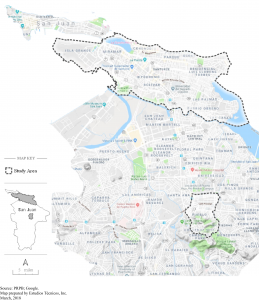
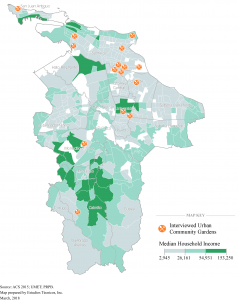
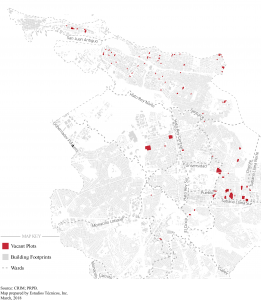
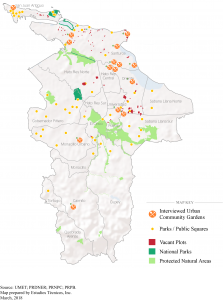
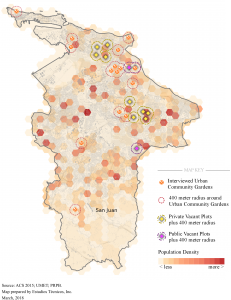
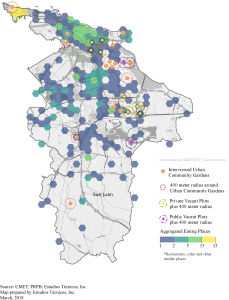
Environmental quality (EQ-AgriTech) results
Soil quality sampling. There is no soil environmental assessment criteria or contamination levels established for agricultural soils or soils that are intended to be reused for urban gardens. The Federal Environmental Protection Agency (EPA) has established assessment levels for risk-based soil cleaning or remediation for anticipated reuse of property (residential, commercial and / or industrial uses). The analytical results obtained in this study were compared to the EPA's Regional Assessment Levels (RSL) in 2017 for chemical contaminants at sites evaluated under the Superfund program. These levels provide comparison values based on exposure risk for residential, commercial and industrial uses. These are concentrations based on different exposure routes that are intended to assist in initial environmental risk assessments but are not regulatory standards. For the purposes of the present analysis, RSLs are used for residential remediation since they are the most restrictive criteria available. In addition, the Preliminary Remediation Goals (PRGs) of Region 9 of the EPA 2009 are used to supplement the RSLs. Although the 2017 EPA RSLs for chemical contaminants were developed with the purpose of integrating the remediation levels and targets established in the different regions of EPA before 2017 (including Region 9 PRGs), for some of the parameters of interest in this study there are no established RSLs.
Metals |
Venus Garden[average]* mg/kg) |
Calle A, Península Cantera [Average*] mg/kg) |
Calle Los Padres, Península Cantera[Average]*, mg/kg) |
Permissible Concentration [mg/kg]40CFR 503.13 |
Arsenic |
ND |
4.6 |
3.75 |
41 |
Cadmium |
ND |
ND |
ND |
39 |
Copper |
47.1 |
49.75 |
1794 |
1500 |
Lead |
6.3 |
33.3 |
96.75 |
300 |
Mercury |
0.0405 |
0.1075 |
0.18 |
17 |
Níquel |
40.9 |
14.9 |
12.25 |
420 |
Selenium |
ND |
ND |
ND |
100 |
Zinc |
40.1 |
105.25 |
317.5 |
2800 |
Educational & Outreach Activities
Participation Summary:
There were three community workshops, six community talks (two of them open massive events) and two final project presentations to San Juan Municipality broaden impact to 1051 direct participants. We reached 88 urban farmers, 77 professionals related to agriculture, 51 policy makers from municipalities of Puerto Rico, planners, engineers, social workers, psychologists, economists, geographers, community leaders, housewives, and students, among other general audiences.
- Gardens Network talk, September 19, 2016, San Juan, PR - The Community Development component had its first orientation to 30 gardeners at the Restaurant Department of Food in Punta Las Marias with the purpose of reactivating the network of orchards with effective strategies.
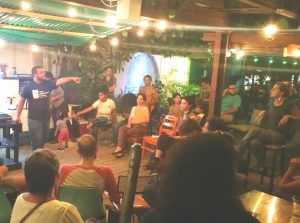
2. Agroecology workshop on February 9, 2017, Río Piedras, PR. Cooperator farmers Ian Pagán and Angel Guevarez giving a workshop on Agroecology to 15 leaders from SJ communities interested in urban farming.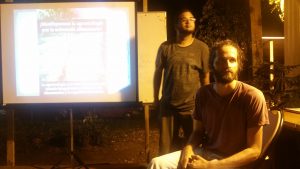
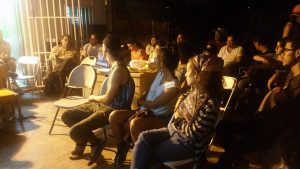
3. Composting Workshop on June 10, 2017, Santurce, PR - Cooperating farmer Angel Guevarez gave a workshop on composting in the Península de Canteras. In addition, the research assistant, Eva Bayona talked about the Garden Network and the steps to follow to make it known. A monthly brigade-workshop plan was worked out to make a tour of all the orchards of SJ. (20 participants)
4. Urban agriculture Fair, San Juan, PR April 26, 2017 - The Urban Agriculture Fair was held at the lobby and gazebos of the Universidad Metropolitana in Cupey. The purpose of this activity was to disseminate, for the first time, the urban agriculture project that aims at the integrated socioeconomic development of urban and peri-urban farmers in marginalized sectors. The fair included 11 farmer exhibits, educational talks, sale of germinates, seedlings, medicinal plants, exhibitions, and massages, among others. The audience was near 200 participants composed of students, faculty, science teachers, Media, and community members, among others.
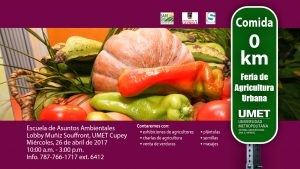

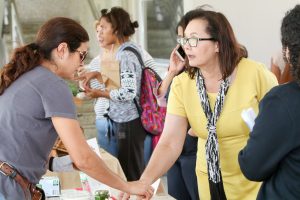
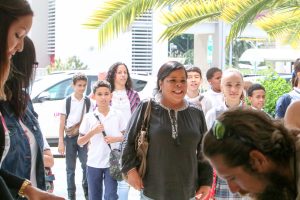
5. Community talk on May 23, 2018. How to develop an Urban Gardens, Venus Gardens, Trujillo Alto, P.R. (32 community participants)
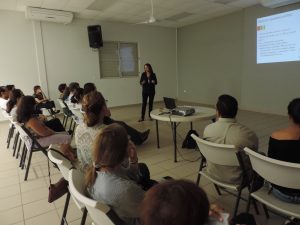
6. Community talk on June 2, 2018. Sustainable Economic Development for Urban Gardens. University of Puerto Rico, Rio Piedras, (32 participants: students from Huerto Semilla and community participants).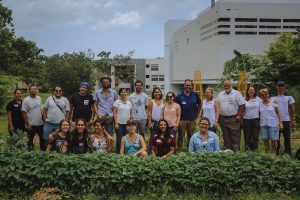
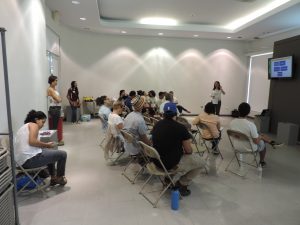
7. Community meeting on September 24, 2018. Community meeting with two leaders of the Housing Cooperative, Ciudad Universitaria, Trujillo Alto that influence 345 residents. They confirmed they are using the Guideline as a toolkit to develop an urban initiative in the housing facilities.
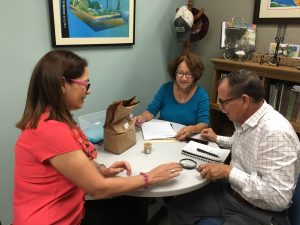
8. Community talk on Saturday, 22, 2018. Talk on Urban Agriculture during the Climate Change Walk organized by Comité de Acción Climática. More than 500 participants from different municipalities of the island, including metro area, north and east of the island attended the event.
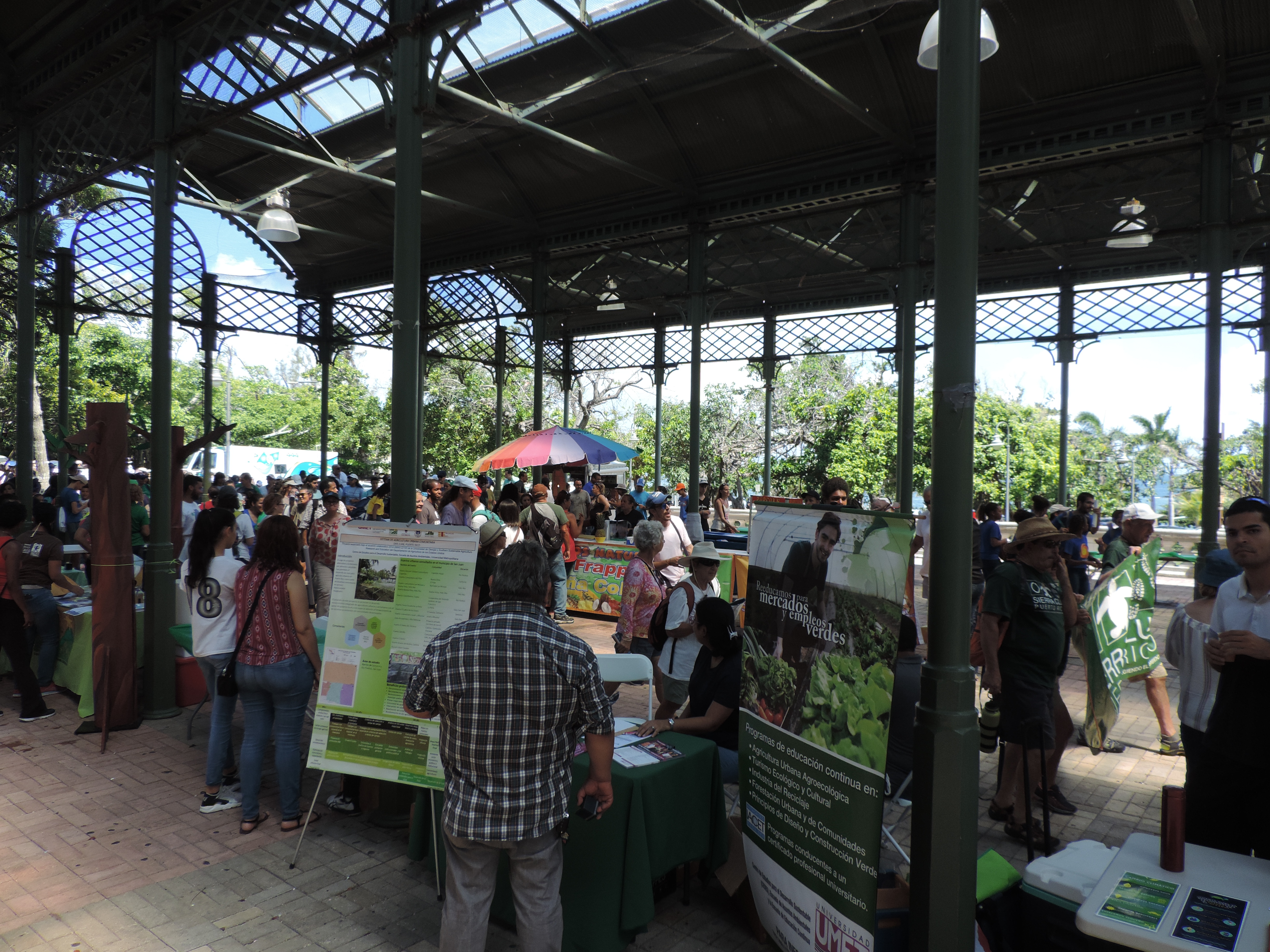
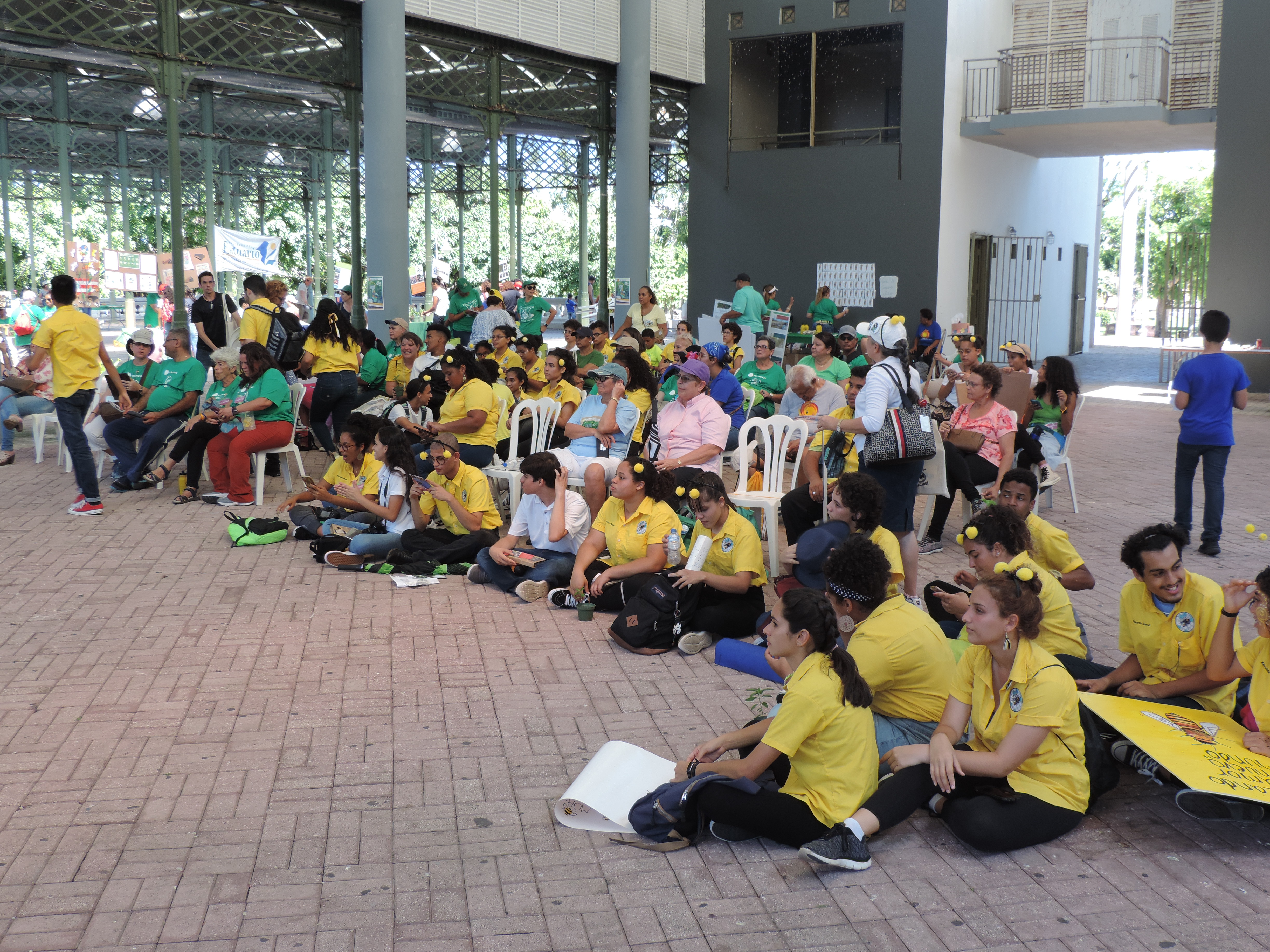
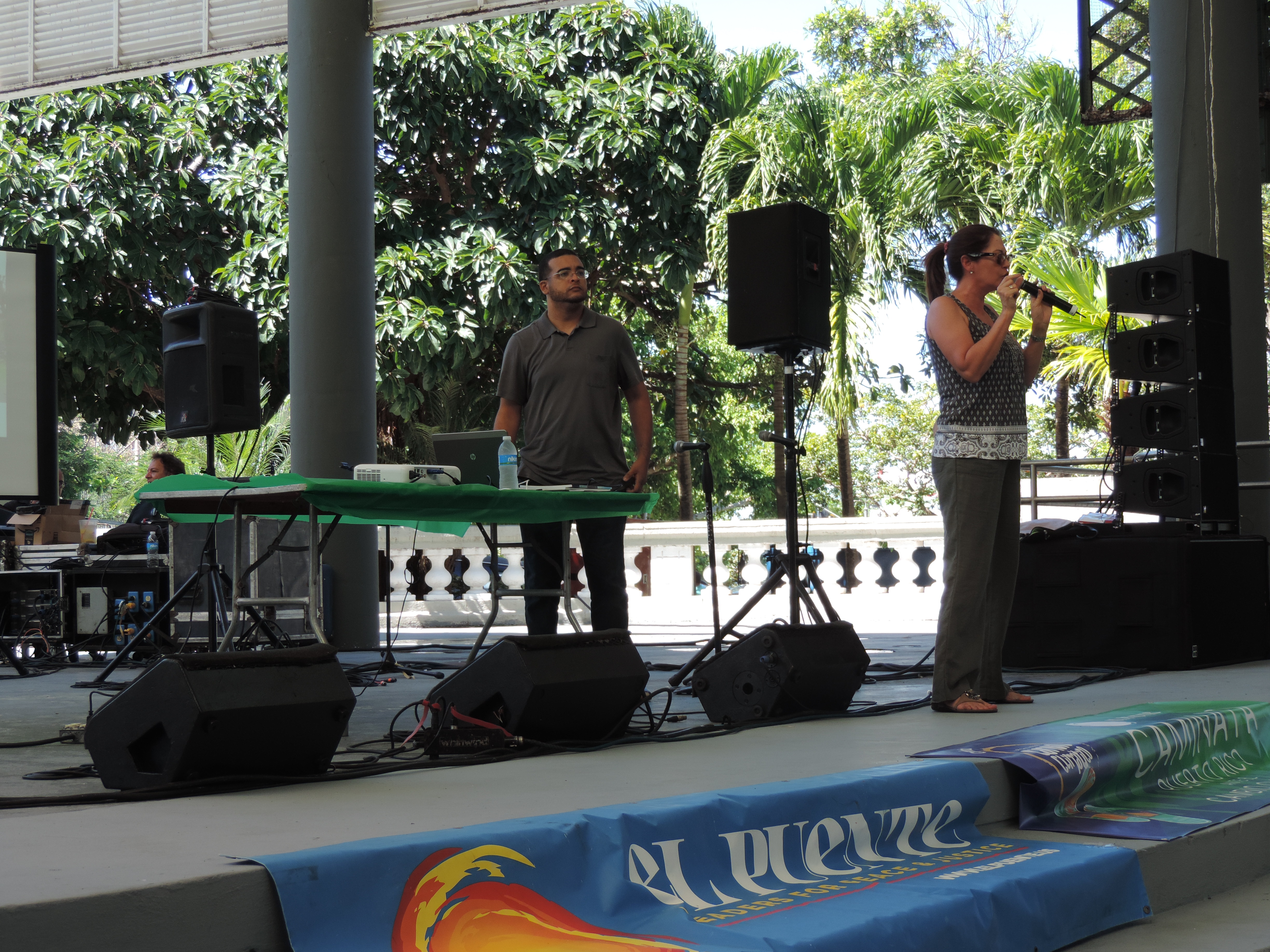
9. Final Project presentation on October 12, 2018, San Juan, PR. Oral presentation to 11 officials from the Municipality of San Juan (Director of Economic Development, the Director of Planning and Territorial Ordinance, the Director of Operation and Ornamentation, the Director of the Education System, among others).
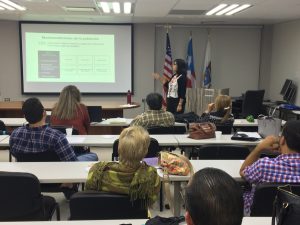
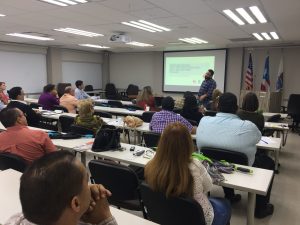
10. Community talk on November 28, 2018. Talk on Guideline Community-based Urban Orchards presentation to Urban Market to Caimito Community, San Juan. (200 participants)
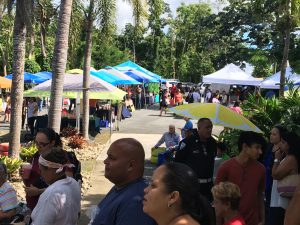
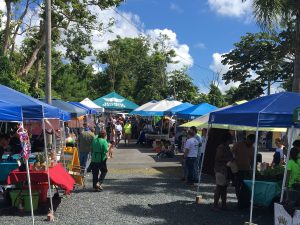
11. Final Project presentation on November 1, 2018. A panel of researchers and cooperators presented the results and distributed the Guideline toolkit to general audience. Forum Sustainable Agriculture: Sovereignty & Food Security. Muñiz Souffront Amphitheater, Universidad Metropolitana, Cupey, 141 on site participants (e.g. planners, agronomists, teachers, 40 municipalities’ policy makers, state and federal government agencies and private entities). Sixty-eight percent of participants were between 31-to 57 years. Additionally, the forum was transmitted by Livestream to 78 views, and was recorded for future actions https://livestream.com/accounts/22023788/events/8436142
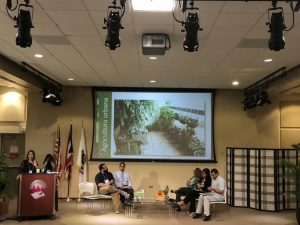
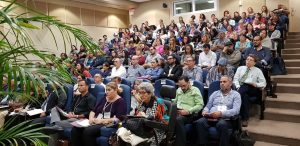
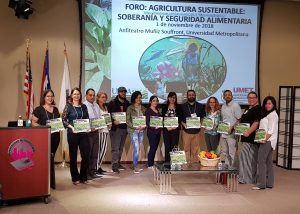
Social network has shared the Guideline among 23 different pages with more than 805 likes and 281 additional shares. Finally, four media coverage (Radio and written press) reaching the whole population trough broadcasting and Internet that remains reaching millions of readers.
- El Nuevo Día main newspaper. Project team interview, Sunday, November 18, 2018. https://www.elnuevodia.com/noticias/locales/nota/creanunaguiadehuertosurbanos-2460356/
- La Perla October 25, 2018. https://www.periodicolaperla.com/crean-guia-para-el-desarrollo-de-huertos-urbanos-comunitarios/
- WAPA Radio, PI interview, Tuesday 20, 2018.
- Metro Newspaper, PI Interview, Wednesday, December 12, 2018 https://www.metro.pr/pr/noticias/2018/12/12/estudian-necesidades-huertos-urbanos-san-juan.html
Learning Outcomes
Awareness on urban orchards location and production in San Juan Puerto Rico
Urban agriculture needs and recommendations
Policy recommendations for urban agriculture in Puerto Rico
Project Outcomes
Impacts
This project constitutes the first systemic approach to urban agriculture in Puerto Rico. For the first time, we have baseline information on urban agriculture system in San Juan. There is a learning community and networking group sharing results and recommendations for the implementation of better practices on urban agriculture in Puerto Rico. At least, three community groups in rural municipalities in Puerto Rico (Cabo Rojo, Trujillo Alto and Cayey) are implementing the Guideline for the Development of Community-Based Urban Orchards in Puerto Rico in their respective projects. As well, this Guideline was submitted as per request by the Community group La Mar de Verde Huertos Urbanos located in Cadiz, Andalucía, Spain.
In terms of public policy, new topics are being drafted as part of the Integral Revision to the Territorial Plan for the Municipality to add urban orchard and community agriculture use as part of its jurisdiction. Moreover, the Municipality has submitted amendments to the Puerto Rico Planning Board to be included in the Land Use Registry Joint Plan, is under revision, so it can be amended, and the orchard and community agriculture are part of the general ruling process throughout Puerto Rico. The plan also includes a plot inventory through the main urban areas of the Municipality, to update de registry of public nuisance properties of the Permits Office.
Our project developed the first urban agricultural fair denominated Food at 0 Kilometers that connected urban agricultural knowledge with participants, teachers and students interested in urban farming system. The event was widely disseminated in Radio, TV and newspapers, before and during the activities.
Nine from 15 urban orchards (9/15) benefitted from University agreements after hurricane María for recovery efforts. We connected urban farmers with volunteers from the School Laboratorio of Interamericana, Organization Para La Naturaleza, Fire Task Force of Puerto Rico, and Las Cucharillas Marsh Project for recovery of urban orchards.
Since 2017, three proposal were granted by the USDA-NIFA that benefit graduate students, communities and public school teachers.
-
Increase Hispanic students’ success in agriculture-related education in Puerto Rico USDA-NIFA- RIIA (2017-2020). The objectives are: to improve the graduate curriculum with agriculture sciences; to increase under-represented graduate students’ support to ensure educational equity and impact recruitment in agriculture-related education and future workforce; and to develop a network of experiential learning opportunities that prepare students for success in the food and agricultural sciences system. The project support 24 credits scholarships, summer internships and stipends for ten (10) graduate students. We developed and approved two graduated courses (6 credits) in Sustainable Agriculture and Urban Agriculture at Universidad Metropolitana, available to those that want to increase knowledge and practice in agriculture sciences.
- Agriculture literacy through Immersive Learning Outdoors Experience, USDA-NIFA-AFFRI (2017-2021). The project geared to increase the number of secondary teachers (8th to 12th grade) trained in food, agriculture, natural resources and humans science in Puerto Rico through a professional development and immersive outdoors experiential learning program. The project has improved knowledge and practice among 20 active teachers for all disciplines from secondary schools (8th to 12th grades) of the Humacao Educational Region (HER), specifically schools from the USDA-Promise Zone in PR.
-
Cataño Communities and Schools Agricultural-Based Learning Experience Project. USDA-NIFA-FASLP (09/15/2018 – 09/14/2020). This project will develop two urban orchards in Cataño (community and School) to implement agricultural-base educational community model, increase knowledge of community and students in agriculture, nutrition and health. The outcome will engage 19 communities, 25 public schools and 20 students from middle and high school.
Accomplishments
Accomplishments/Milestones:
- Publication: Guideline for the Development of Community-Based Urban Orchards in Puerto Rico. http://www.anagmendez.net/umet/pdf/cedes_guia_huertos_urbanos_comunitarios.pdf
- Master thesis based-upon our project. A graduate student and research assistant of our project completed her Master thesis entitled Sustainability indicators for urban gardens in San Juan, Puerto Rico based on this project. Her research analyzed five criteria: biophysics, technology, cultural, socioeconomics and management of urban gardens according attributes of sustainability: productivity, stability, resilience, reliability, adaptability, equality and self-management. Results shown that urban gardens analyzed lacked of several sustainability factors such as support from government agencies, have a low community participation rate, low agro production, low workforce and absence of organizational structure. The document proposed a plan for further actions to increase their sustainability.
- Official meeting: Project results presentation to 11 officials from the Municipality of San Juan (Director of Economic Development, the Director of Planning and Territorial Ordinance, the Director of Operation and Ornamentation, the Director of the Education System, among others)
- Forum: Sustainable Agriculture: Sovereignty & Food Security. Project results presentation to general audience and distributing the Guideline toolkit. Muñiz Souffront Amphitheater, Universidad Metropolitana, Cupey, 141 on site participants (e.g. planners, agronomists, teachers, 40 municipalities’ policy makers, state and federal government agencies and private entities). Sixty-eight percent of participants were between 31-to 57 years. Additionally, the forum was transmitted by Livestream to 78 views, and was recorded for future actions https://livestream.com/accounts/22023788/events/8436142
- Media coverage
- El Nuevo Día main newspaper. Project team interview, Sunday, November 18, 2018. https://www.elnuevodia.com/noticias/locales/nota/creanunaguiadehuertosurbanos-2460356/
- La Perla October 25, 2018. https://www.periodicolaperla.com/crean-guia-para-el-desarrollo-de-huertos-urbanos-comunitarios/
- WAPA Radio interview, Tuesday 20, 2018.
- Metro Newspaper, PI Interview, Wednesday, December 12, 2018 https://www.metro.pr/pr/noticias/2018/12/12/estudian-necesidades-huertos-urbanos-san-juan.html
Our experience with SSARE related with financial administration and implementation of this project was excellent. We are very grateful of SSARE response in all dimensions. There are no further recommendations, except for those related with public policy in the USDA to include urban agriculture and enhance the situation of urban farmers.
Information Products
- Urban Agriculture Community System (Display)
- Urban Agriculture: Food 0Km (Website)